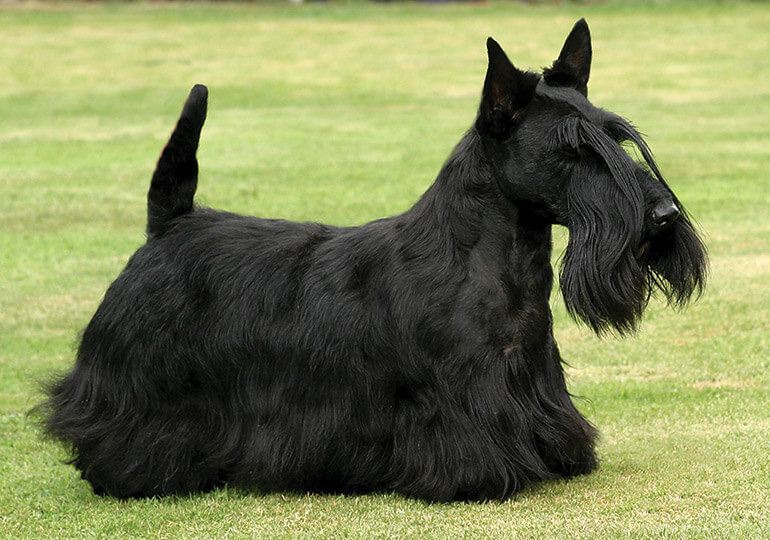Scottish Terrier Dog Breed | Description, Temperament, Lifespan, & Facts
The Scottish Terrier, affectionately known as the “Scottie,” is a small but robust breed renowned for its distinctive appearance and spirited personality. Originating from Scotland, this breed was initially developed to hunt and kill vermin on farms. Today, Scottish Terriers are cherished as loyal companions and family pets, known for their courage, confidence, and dignified demeanor.
Contents
- 1 Scottish Terrier Historical Background
- 2 Scottish Terrier Appearance
- 3 Temperament
- 4 Health and Lifespan
- 5 Care and Maintenance
- 6 Training and Behavior
- 7 Nutrition
- 8 Living Conditions
- 9 History and Origin
- 10 Fun Facts
Scottish Terrier Historical Background
The Scottish Terrier’s history dates back to the early 17th century in the Scottish Highlands. Initially bred for hunting small game-like rats and foxes, these dogs quickly earned a reputation for their tenacity and determination. They were recognized by the American Kennel Club (AKC) in 1885 and have since been a popular breed among dog enthusiasts.
Scottish Terrier Appearance

Physical Characteristics
The Scottish Terrier is a compact, sturdy dog with a distinctive silhouette. They typically weigh between 18 to 22 pounds and stand about 10 inches tall at the shoulder. Their coat is a hallmark of the breed, characterized by a dense, wiry outer coat and a soft undercoat. Common coat colors include black, wheaten, and brindle.
Size and Weight
Scottish Terriers are small but mighty. Despite their modest size, they are muscular and strong. Their robust frame and deep chest give them a powerful presence, while their short legs and elongated body make them agile and capable hunters.
Coat and Colors
The Scottie’s coat requires regular grooming to maintain its texture and appearance. The most common color is black, but wheaten and brindle are also seen. Their distinctive eyebrows and beard add to their unique and charming look.
Distinctive Features
The Scottish Terrier’s face is one of its most recognizable features, with expressive, almond-shaped eyes and large, erect ears. Their strong jaw and pronounced muzzle give them a determined expression, reflecting their bold nature.
Temperament

Personality Traits
Scottish Terriers are known for their independent and confident temperament. They are often described as “big dogs in small bodies” due to their assertive and fearless nature. Despite their independence, they form strong bonds with their families and can be very affectionate.
General Disposition
Scotties are loyal and protective, making them excellent watchdogs. They can be reserved with strangers but are generally good with children and other pets if properly socialized. Their intelligence and curiosity make them engaging companions, though they can also be a bit stubborn at times.
Interaction with Family
Scottish Terriers thrive in a family environment where they receive plenty of attention and interaction. They enjoy playing with children and can be quite playful, although they also appreciate quiet time to themselves. Their loyalty to their family is unwavering, and they often form deep bonds with their human companions.
Behavior with Other Pets
With proper socialization, Scottish Terriers can coexist peacefully with other pets. However, their hunting instincts may lead them to chase smaller animals. Early training and exposure to different environments and animals can help mitigate any potential issues.
Health and Lifespan
Common Health Issues
Like all breeds, Scottish Terriers are prone to certain health conditions. Common issues include:
- Von Willebrand’s disease (a bleeding disorder).
- Craniomandibular osteopathy (a condition affecting the bones of the skull).
- Various cancers.
Regular veterinary check-ups and preventive care are essential to keep them healthy.
Genetic Conditions
Scottish Terriers can inherit several genetic conditions. Responsible breeders test for these issues to reduce the risk of passing them on to puppies. Prospective owners should inquire about health clearances for the breed’s common conditions.
Preventative Care
Routine veterinary care, a balanced diet, and regular exercise are crucial for maintaining the health of a Scottish Terrier. Preventive measures, such as vaccinations, dental care, and parasite control, also play a significant role in their overall well-being.
Lifespan
The average lifespan of a Scottish Terrier is around 12 to 15 years. Factors such as genetics, diet, exercise, and overall care can influence their longevity. Providing a healthy lifestyle and regular veterinary care can help ensure a long and happy life for your Scottie.
Care and Maintenance
Grooming Needs
The Scottish Terrier’s coat requires regular grooming to keep it in top condition. This includes brushing several times a week to prevent matting and tangling, as well as periodic hand-stripping or clipping to maintain the coat’s texture. Regular grooming sessions also provide an opportunity to check for any skin issues or parasites.
Coat Maintenance
To keep a Scottie’s coat looking its best, owners should invest time in proper grooming. This includes routine brushing, occasional baths, and professional grooming every few months. Maintaining their coat not only keeps them looking good but also prevents skin problems and discomfort.
Bathing and Hygiene
Scottish Terriers should be bathed as needed, typically every month or two, using a mild dog shampoo. Regular ear cleaning, nail trimming, and dental care are also important aspects of their hygiene routine.
Exercise Requirements
Scottish Terriers are energetic and require regular exercise to stay healthy and happy. Daily walks, playtime, and mental stimulation are essential to meet their needs. While they enjoy outdoor activities, they can also adapt to apartment living as long as they get sufficient exercise.
Activity Levels
Scotties are active dogs that enjoy a variety of activities, from brisk walks to interactive games. They thrive on mental and physical stimulation, making them excellent candidates for activities like agility training and puzzle toys.
Suitable Activities and Exercises
Engaging a Scottish Terrier in activities like fetch, hide-and-seek, and training sessions can help keep them mentally and physically fit. Regular exercise also helps prevent behavioral issues that can arise from boredom and excess energy.
Training and Behavior
Training Tips
Training a Scottish Terrier requires patience, consistency, and positive reinforcement. They are intelligent and can learn quickly, but their independent nature means they may sometimes test boundaries. Short, engaging training sessions work best, and using rewards like treats and praise can motivate them.
Basic Commands
Teaching basic commands such as sit, stay, come, and heel is essential for managing a Scottish Terrier’s behavior. Early socialization and training are crucial to help them develop into well-behaved adults.
Socialization
Exposing Scottish Terriers to various people, animals, and environments from a young age helps them become well-adjusted and confident. Socialization helps prevent fearfulness and aggression and promotes a friendly disposition.
Common Behavioral Issues
Scottish Terriers, like many breeds, can develop behavioral issues if not properly trained and socialized. Common issues include digging, barking, and stubbornness. Addressing these behaviors early with positive training techniques can help mitigate problems.
How to Address Them
Consistent training, mental stimulation, and exercise are key to addressing behavioral issues in Scottish Terriers. Providing clear boundaries and rewarding good behavior can help reinforce positive habits. Consulting with a professional trainer or behaviorist may also be beneficial for more challenging behaviors.
Nutrition
Dietary Needs
A balanced diet is crucial for the health and well-being of a Scottish Terrier. High-quality commercial dog food, tailored to their age, size, and activity level, typically meets their nutritional needs. Owners should also ensure their dog has access to fresh water at all times.
Recommended Diet
A diet rich in protein, healthy fats, and essential vitamins and minerals supports the health of a Scottish Terrier. Owners can consult with their veterinarian to determine the best diet plan, whether it’s commercial kibble, wet food, or a raw diet.
Feeding Schedule
Establishing a regular feeding schedule helps maintain a healthy weight and digestion. Most Scottish Terriers do well with two meals a day, with portion sizes adjusted based on their age, weight, and activity level.
Living Conditions
Ideal Home Environment
Scottish Terriers are adaptable and can thrive in various living conditions, from apartments to larger homes. They prefer a calm environment where they can form close bonds with their family members. A securely fenced yard provides a safe space for them to explore and play.
Indoor vs. Outdoor Living
While Scotties enjoy outdoor activities, they are primarily indoor dogs and should live inside with their family. They do well in various climates but may need extra care in extreme weather conditions.
Adaptability to Various Living Spaces
Scottish Terriers can adapt to apartment living as long as they receive adequate exercise and mental stimulation. They appreciate having a cosy, designated space indoors where they can retreat and relax.
History and Origin
Breed History
The Scottish Terrier’s history is rich and fascinating. Originating in Scotland, they were initially bred to hunt vermin on farms. Their keen sense of smell and determination made them excellent hunters. Over time, they transitioned from working dogs to beloved companions, admired for their unique appearance and spirited personality.
Origins and Development
The breed’s development involved selective breeding to enhance their hunting abilities and physical traits. The Scottish Terrier’s distinctive look and bold character have been carefully preserved through generations of breeding.
Role in History
Scottish Terriers have left their mark on history, with notable owners including President Franklin D. Roosevelt, whose Scottie Fala became a national icon. Their presence in literature, art, and popular culture further cements their status as a beloved and iconic breed.
Fun Facts
Interesting Tidbits
- Scottish Terriers are often called “diehard” due to their tenacious nature.
- They were one of the first breeds to be exhibited in dog shows, starting in the 19th century.
- The Scottie is one of the five breeds that make up the “Terrier Group” in dog shows.
Unique Characteristics
Scotties are known for their distinctive “beard” and “eyebrows,” which add to their charming and expressive faces. Their confident strut and keen sense of smell make them stand out among other breeds.
Famous Scottish Terriers
Fala, President Roosevelt’s Scottie, is perhaps the most famous Scottish Terrier, symbolizing loyalty and companionship. The breed has also been featured in various films and books, and it has even been a playing piece in the classic board game Monopoly.
FAQs
Is a Scottish Terrier a good family dog?
Yes, Scottish Terriers can be excellent family dogs. They are loyal, affectionate, and protective of their loved ones. With proper training and socialization, they can get along well with children and other pets.
What are Scottish Terriers used for?
Historically, Scottish Terriers were used for hunting and killing vermin. Today, they are primarily kept as companion animals, cherished for their loyalty, intelligence, and distinctive appearance.
Are Scottish Terriers cuddly?
While Scottish Terriers are affectionate with their families, they can also be quite independent. They enjoy spending time with their loved ones but may not be as cuddly as some other breeds. Their loyalty and protective nature make them wonderful companions.
Does a Scottish Terrier bark a lot?
Scottish Terriers can be vocal and are known to bark, especially when they sense something amiss. Proper training and socialization can help manage excessive barking and ensure they only bark when necessary.
Conclusion
The Scottish Terrier is a remarkable breed with a rich history and a distinctive personality. Their unique appearance, loyal temperament, and adaptable nature make them beloved companions. Whether as a family pet or a loyal friend, the Scottish Terrier continues to capture the hearts of dog lovers around the world.
Final Thoughts on the Breed
Choosing a Scottish Terrier means welcoming a spirited, intelligent, and loyal companion into your home. With proper care, training, and love, these “diehard” dogs will provide years of joy and companionship. If you’re looking for a small dog with a big personality, the Scottish Terrier might be the perfect match for you.
- Golden Retriever Pros and Cons: What Every Pet Parent Should Know - 15 September 2025
- Cane Corso Dog Breed: Health, Care, and Lifespan - 14 September 2025
- Catahoula Leopard Dogs: Description, Temperament, Lifespan, & Facts - 21 July 2025







